Environmental protection usually requires regulations. But sometimes the market really can solve problems when the…
The post Office Conversions Could Be the Key to Urban Renewal appeared first on Earth911.

Environmental protection usually requires regulations. But sometimes the market really can solve problems when the…
The post Office Conversions Could Be the Key to Urban Renewal appeared first on Earth911.
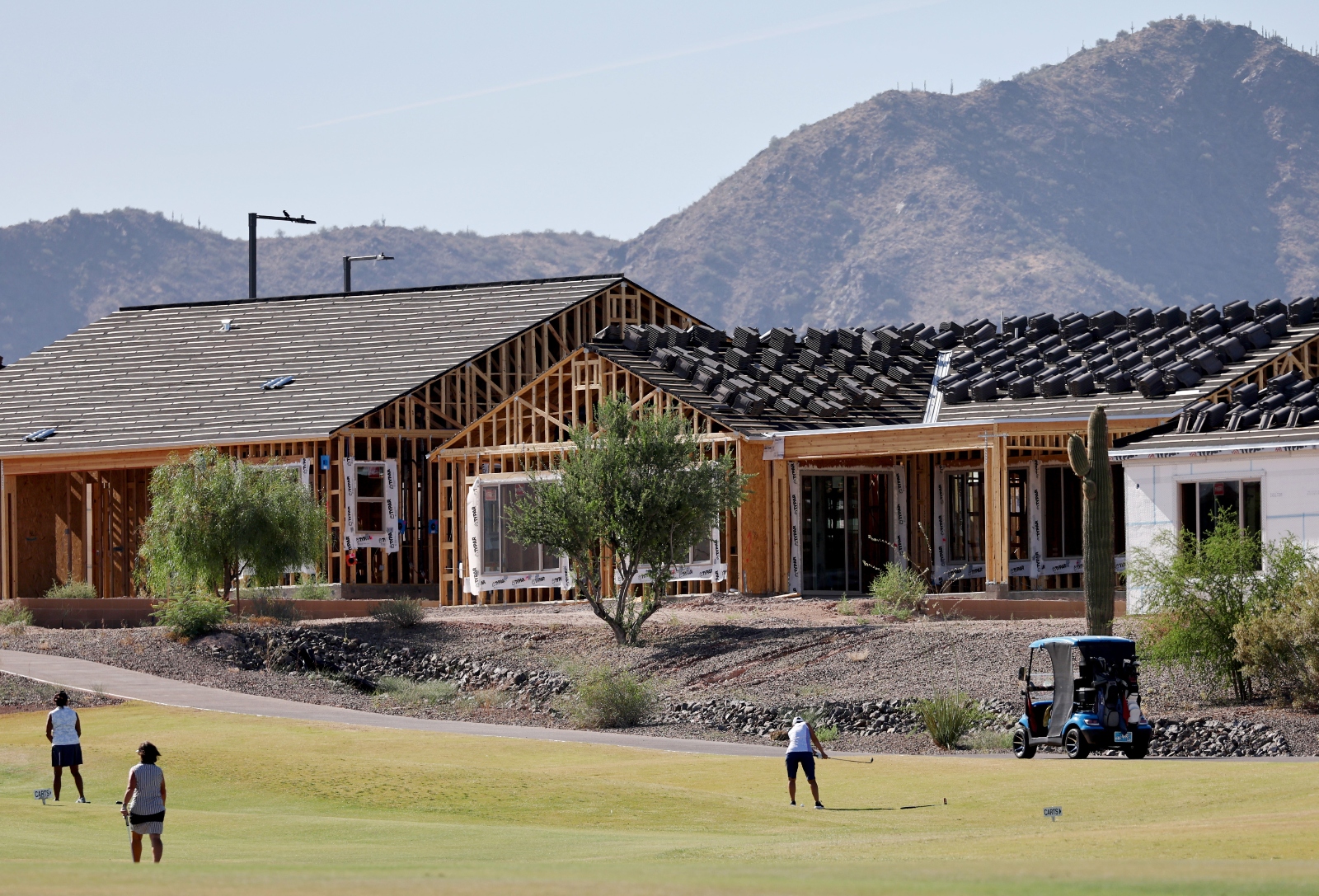
This story was originally published by The Guardian and is reproduced here as part of the Climate Desk collaboration.
Arizona, stressed by years of drought, has declared its house-building boom will have to be curbed due to a lack of water, but one of its fastest-growing cities is refusing to give up its relentless march into the desert — even if it requires constructing a pipeline that would bring water across the border from Mexico.
The population of Buckeye, located 35 miles west of Phoenix, has doubled over the past decade to just under 120,000, and it is now priming itself to eventually become one of the largest cities in the U.S. West. The city’s boundaries are vast — covering an area stretching out into the Sonoran Desert that would encompass two New York Cities — and so are its ambitions.
Buckeye expects to one day contain as many as 1.5 million people, rivaling or even surpassing Phoenix — the sixth largest city in the U.S. that uses roughly 2 billion gallons of water a day — by sprawling out the tendrils of suburbia, with its neat lawns, snaking roads, and large homes, into the baking desert.
Arizona’s challenging water situation appears a major barrier to such hopes, however. In June, the state announced that new uses of its groundwater have essentially hit a limit, placing restrictions on house building, just a few months after the state lost a fifth of its water allocation from the ailing Colorado River.
There isn’t enough water beneath Buckeye to support homes not already being built, Arizona’s water department has said. But the city is embarking upon an extraordinary scramble to find water from other sources — by recycling it, purchasing it, or importing it — to maintain the sort of hurtling growth that continues to propel the U.S. West even in an era of climate crisis.

“Personally, my view is that we are still full steam ahead,” said Eric Orsborn, Buckeye’s ebullient mayor. Orsborn said he understands the state has to be “really careful” with water resources but that the city is exploring “options to keep us going and allow us to continue to grow at the rate that we want to grow.”
Some of the grander options are ambitious to the point of appearing outlandish, such as a plan to bring desalinated seawater from Mexico to Arizona via a lengthy, uphill pipeline. Arizona may, instead, pipe in water west from California, or from 1,000 miles east, from the Missouri River. Buckeye has already shown it is prepared to spend big to achieve its dreams — in January the city council agreed to spend $80 million for a single acre of nearby land, an area smaller than a football pitch, just to secure its attached water rights.
“We’ll be as big or larger than Phoenix, ultimately — we don’t have to have all that water solved today,” Orsborn said in city hall, which itself may have to be upsized to deal with Buckeye’s growth. On his office wall is a map of the vast expanse of untouched desert that sits within the city’s voluminous territory.
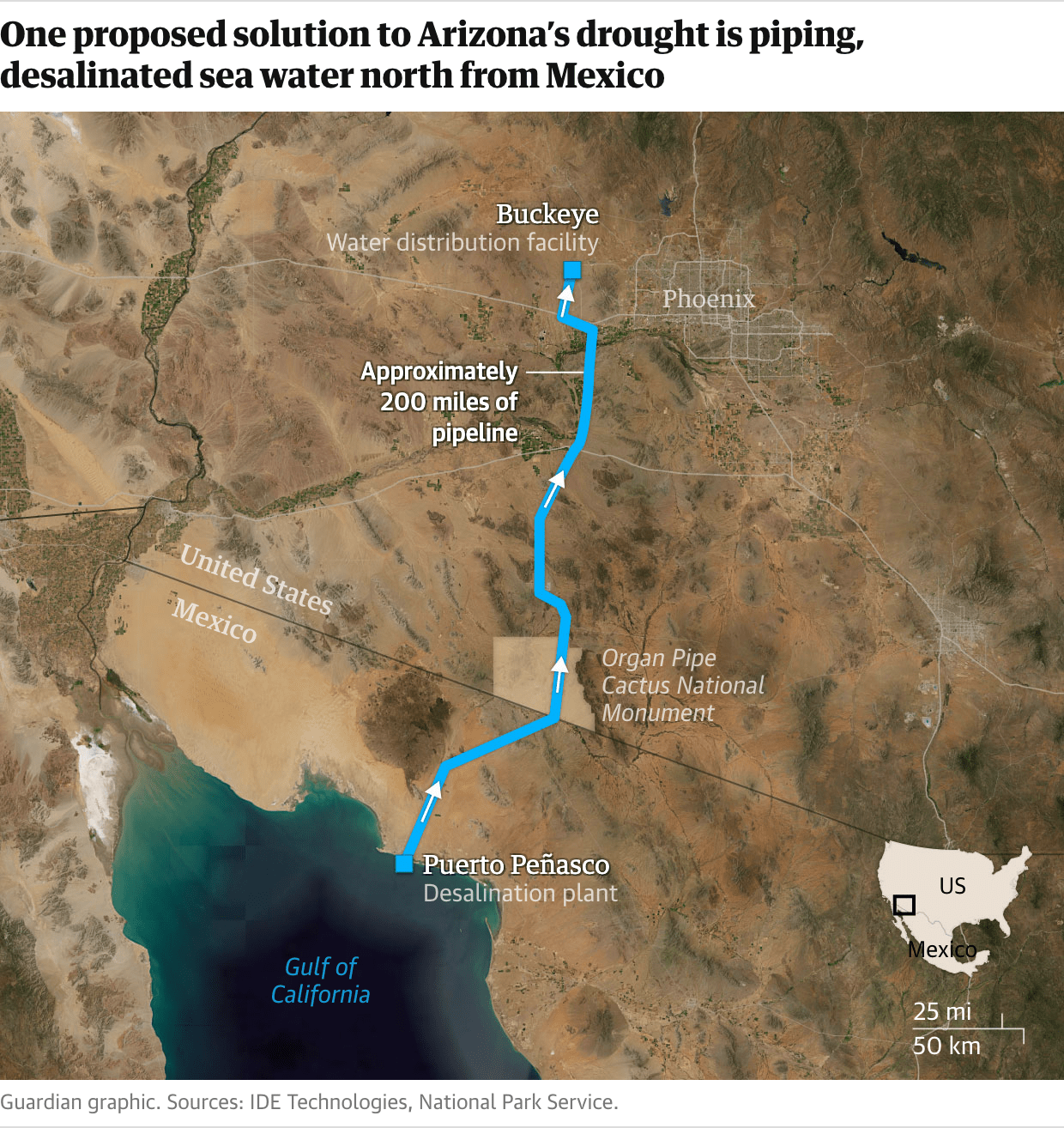
“What we need to figure out is what’s that next crazy idea that’s out there,” said the mayor, who also owns a construction company. “We’re just hustling to get to that point, to keep things moving along.”
Perhaps the most “crazy” of the ideas is the one that would involve building a desalination plant in the Mexican town of Puerto Peñasco, perched on the edge of the Gulf of California, to suck up seawater and then send the treated water in a pipeline several hundred miles north to Arizona. Much of the pipeline’s proposed route is uphill and will traverse an international border, a federally protected area famed for its cactus and several small towns.
Environmentalists have already criticized the plan for its potential ecological impact upon both land and sea — the salty brine left over would be dumped back into the Gulf of California, altering its composition and potentially harming its marine life. The odds may be against the pipeline, given the cost and opposition. But IDE, the Israeli company that proposed the $5 billion plan, has said the pipeline would be “transformative” for Arizona, would provide enough water for the entire state and “secure Arizona’s future growth.”
Arizona’s Water Infrastructure Finance Authority (or WIFA), the agency tasked with implementing a new inflow of water to the state, is assessing the Mexico idea, as well as other options. Chuck Podolak, director of the agency, has his own office map that helps him envision other possible stupendous infrastructure undertakings, such as a pipeline running from another desalination plant, in California, or a pipeline that could convey water from the distant Missouri River to the thirsty desert.
“Those are big, audacious ideas, but I don’t think any are off the table,” said Podolak. “We’re going to seek the wild ideas and fund the good ones.”
Podolak acknowledged any pipeline from Mexico will face numerous hurdles — Wifa has been in touch with lawmakers in Mexico, some of whom are unfavorable to the idea — but insisted Arizona will continue to push for a new, leviathan project to make up its water shortfall.
“I just want to see multiple projects and figure out the best one for us. If we want to have that long-term security, we do need a new bucket, so to speak, a new source of supply outside of the state. This is a fantastic place to live.”

Podolak points out such big ideas are in keeping with previous monumental, and seemingly impossible, projects. “We dammed up the Colorado River and built the Hoover Dam, we have an artificial river that runs from Lake Havasu to Tucson uphill 300 miles — it’s called the Central Arizona Project,” he said.
“All these things seemed audacious, but now they’re part of the landscape. We’ve been doing it for 100 years.”
Such grandiose plans are being mulled because Arizona faces pressures like never before. The state has been in the teeth of a drought, spurred by global heating, that is the worst the U.S. Southwest has seen in approximately 1,200 years. About a third of the state’s water supply comes from the Colorado River, which has shrunk as temperatures have risen. Last year, under a mechanism where Arizona shares water with other states, its allotment of Colorado River water was cut by 21 percent.
Arizona’s other major water source — from underground aquifers, sucked up by wells — has become depleted in some parts of the state and, in the rapidly growing areas on the fringes of Phoenix, have been entirely laid claim to by developers who have to show under law that there is a reliable 100-year supply of water before erecting new homes on the cheap desert land.
In June, in a sobering dose of reality, the state declared there was not enough water for all current planned construction in the Phoenix region — amounting to a 4 percent shortfall over the next century — and that all future housing developments will have to find some other source of water. Already approved projects, and new housing within Phoenix itself, could still continue, the state stressed. “We are not out of water and we will not be running out of water,” said Katie Hobbs, Arizona’s governor.
While the decision won’t halt Arizona’s growth — which has been fueled by relatively cheap housing, fine weather, and fresh jobs brought by firms such as Intel and newcomer battery manufacturers — some see the end of an era in which sprawling homes, swimming pools, lawns, and water-intensive crops could endlessly unfurl into the desert.
“It’s a clear sign that this sprawl was never sustainable and that there is just no more groundwater left to do that,” said Christopher Kuzdas, senior water program manager at Environmental Defense Fund who argues Arizona should better conserve its own groundwater before turning to new pipelines.
“We are at a real crossroads as to how Arizona grows,” he said. “There just aren’t many easy options left when it comes to water.”
For Buckeye, the conversion of farmland to new housing will subsume existing irrigation rights — agriculture takes up more than 70 percent of Arizona’s water, after all, with Hobbs recently removing state land from being used to grow alfalfa, a particularly thirsty, and controversial, crop in order to protect what she called the state’s “water future.”
Beyond that, as the city expands into virgin desert, there is water recycling, where waste water is treated and reused, or perhaps a raising of the dam on the nearby Verde River to collect more water. Any new water pipeline from further away will take many years, and billions of dollars, if it happens at all. But Orsborn insists the city will find a way.
“I’m not saying it’s not going to be a challenge, but it’s not going to break that growth,” said the mayor. “For thousands of years, water’s been moved from one point to another point. We just have to continue to do that.”
Driving around Buckeye — there isn’t really any other option to get around — can feel rather disjointed. The city’s downtown is somewhat threadbare but then at the periphery there is a frenzy of building activity, with rows of new beige and cream colored houses with piles of roof slates being put in place, swarms of machinery preparing dusty tracts of ground, flags fluttering with legends such as “new homes” and “now selling.”

Drive a further 30 minutes north into the desert, a mix of scrubland dotted with saguaro cacti and two starkly beautiful mountain outcrops, you’re somehow still in Buckeye and work is under way to conjure up a massive new development called Teravalis — meaning “land of the valley” — that calls itself a “city of the future” that will eventually house 300,000 people and various businesses.
“We are effectively building a small city,” said Heath Melton, president of the Phoenix region for the developer, the Howard Hughes Corporation. Teravalis will reclaim water and be cautious with its use of turf and irrigation, according to Melton. “We want to enrich people’s lives and be good stewards of the environment,” he said. “Buckeye is very bullish on its growth and it’s good for them to be bullish.”
For the optimists, Arizona’s past is instructive. The state has found spectacular fixes to secure the water that has catapulted its growth and is getting better at saving it — somehow Arizona uses less water than it did in the 1950s despite now having 500 percent more people.
But past conditions bear a dwindling resemblance to Arizona’s future. This summer was, globally, probably the hottest that humans have ever experienced. In Phoenix, there were a record 31 consecutive days above 100 degrees F (37 degrees C) and the seasonal monsoon season was the driest since 1895. It will only get hotter and drier. Arizona may be able to move the sea from Mexico, but somehow out-engineering the climate crisis in the longer term will be an even more grueling feat.
“I think Buckeye has some real challenges and the degree of their success will depend on the degree to which people are willing to pay for those more expensive solutions,” said Kathryn Sorensen, an expert in water policy at Arizona State University.
“But it’s absolutely feasible,” she adds. “We pave over rivers, we build sea walls, we drain swamps, we destroy wetlands, we import water supplies where they never would have otherwise gone. Humans always do outlandish things, it’s what we do.”
This story was originally published by Grist with the headline Welcome to Buckeye, the desert city out to surpass Phoenix by importing water on Oct 22, 2023.
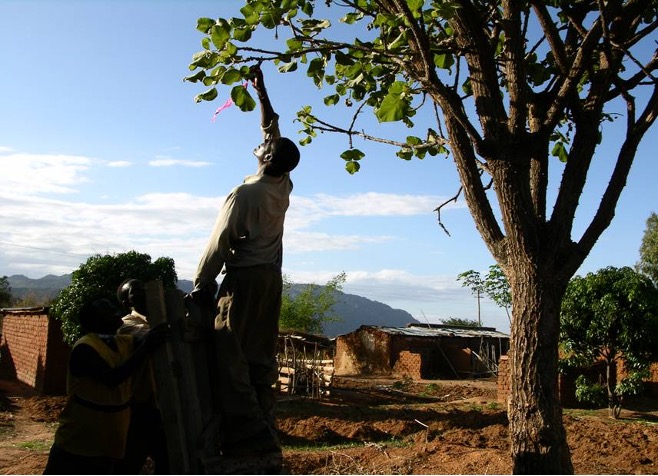
This story was originally published by Honolulu Civil Beat and is republished with permission.
Mohsen Ramadan’s name is stamped on the corner of a yellowing copy of entomologist Fillipo Silvestri’s 1914 report on Mediterranean fruit flies.
The record chronicles Silvestri’s 11-month voyage from Europe, around Africa, to Australia and, finally, Hawai’i. Along the way, Silvestri collected parasites of the fruit fly, one that was ravaging Hawaiian horticulture at the time. The then-U.S. territory was suffering, its products barred from entering the mainland.
The African wasps Silvestri introduced to Hawai’i did the job, killing off the problem. It’s an early example of biological control in Hawai’i, a scientific realm that continues to be paramount to the state’s ecological and agricultural balance.
But government bureaucracy and inadequate research facilities are now blamed for delaying potentially significant relief to industries like macadamia and coffee and possibly even providing a “silver bullet” in the battle against the invasive grasses that fueled the deadly wildfires on Maui.
Silvestri’s work more than a century ago inspired Egyptian-born Ramadan to move to Hawai’i in 1981, to study at the University of Hawai’i, and eventually become a modern-day Silvestri, the Department of Agriculture’s only exploratory entomologist.
Ramadan has spent the past 26 years in the role, traveling between Hawai’i and more than a dozen countries, scouting for insects and pathogens that could be introduced to help eradicate or control invasive insects and weeds across Hawai’i.
His research has taken him across Southeast Asia for melon flies, maile pilau, and banana aphids and throughout Africa to find enemies of fireweed, coffee berry borer, and erythrina gall wasp, among other places and pests.
His name has since appeared on more than 68 journal articles. And given that he works in Hawai’i — the invasive species and extinction capital of the world — there are plenty more in the pipeline.
Ramadan’s most recently published article is on the macadamia felted coccid, a microscopic pest to Hawaii’s lucrative macadamia nut industry.
His research shows it will be successful, but its release has been a decade in waiting, as regulations and permitting hold up the process.
“I do not complain much,” Ramadan said. “But this … this is a really long time.”
When the wiliwili tree was facing extinction in the summer of 2005, Ramadan ventured to Tanzania to find solutions. Biologists who were colleagues at UH traveled with him across southern Africa, together finding 30 potential solutions by the end of 2006.

Four years later, a wasp was released in Hawai’i as a biological control agent.
It was a rapid response, especially considering the bureaucratic steps involved in the process, according to UH entomology professor Mark Wright, who worked with Ramadan on the project.
“Sometimes it can take 20 years to get something like that to happen,” Wright said.
The process of identifying and locating potential biocontrol agents might take a few months or a year, but the permitting process can take far longer because delays are possible at every step on the federal or state level.
Entomologists such as Wright and Ramadan accept that the lengthy process is there for a reason but still bristle with it, especially as such problems seem acute.
The macadamia nut industry awaiting final sign-off to release a miniscule Australian wasp to kill off the felted coccid is another example.
Without being able to deploy the wasp yet to control the pest, the industry is left with the use of pesticides as the only viable alternative to stay in business, Hawaii Macadamia Nut Association President Nathan Trump says.
The industry has been effectively pesticide-free for the past 20 years, thanks to biological controls, according to Trump.
“As an organic macadamia nut farmer, I would much prefer to import and release beneficial insects, as opposed to paying thousands of dollars to chemical companies for products that can degrade our environment and harm human health,” Trump said in an email.
HMNA secretary Bonnie Self said the cost of spraying, with pesticides becoming increasingly expensive, spells the difference between breaking even and going into the red.
“But the cost of not spraying could be a loss of production or even the loss of an orchard,” Self said.
Hawai’i has a complex relationship with both pesticides and biological controls though, fed by global agrochemical conglomerates’ history in the islands and failed species control measures.
But to control invasive species, using what the sector calls integrated biological control, there is no entirely palatable solution.
Without biological controls, the only management options are manual or through chemicals.
DOA Plant Pest Control Branch Manager Darcy Oishi says the decision over what is better — pesticides or introduced species — is up to the public.
The state has a long history of controlling undesirable species with enemies from their home ranges, bringing in 679 species of weeds and insects between 1890 and 1985.
When asked about unintended consequences, Ramadan retrieves three records: a large book for the years until 1985, a sheet of paper for the 72 agents imported between 1987 to 2000, and a sliver of paper for the years until 2015.
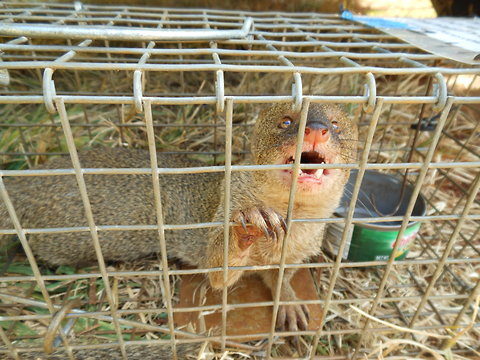
That decline is in part because warning bells were sounded in the mid-1980s, when the unintended effects of control agents’ introduction were highlighted by scientists, which led to a tightening of biosecurity measures worldwide.
Still, Ramadan is quick to point out that of the species introduced between 1890 and 1985, 13.6 percent had an effect on non-target species. Only 7 percent had any effect on native species in Hawaii, and none got close to killing them off.
And since 1967, none of the releases have had unintended effects, he said.
A popular example of failed biocontrols is the mongoose, which was introduced by plantations to control rat populations. The mongoose has since wreaked havoc on bird populations locally.
But that introduction, along with several others, were conducted outside the scientific process and at a time when ecosystem management was an afterthought.
Agriculture was the only consideration, but now entire ecosystems have value in the public eye, which fundamentally changes the entire process, Oishi said.
“We have mongoose and cane toad as permanent issues because there was a lack of pondering, philosophical thought, self-reflection and assessment on what is going to be the long-term impact,” Oishi said. “There was no generational approach.”
But there are functional realities that need to be addressed if there is to be more biological control in Hawai’i.
Chief among those barriers is the two facilities that exist in the state, according to Hawaii Invasive Species Council planner Chelsea Arnott.
“They’re outdated. They’re small. They don’t have the containment ratings to be able to work on really small organisms,” Arnott said.
Updating that infrastructure could make a substantial impact for environmental protection and reducing the effects of invasive species.
Oishi estimates it would cost approximately $5 million to build such a facility, with about $800,000 per year to keep it running.
That could serve to increase biological control work exponentially.
“There’s a volume discount, basically,” Oishi said.
At 71 years old, Ramadan has one final invasive species he wants to target before he retires: fountain grass.
That grass has been deemed invasive for years but was among the many blamed for fueling the August 8 Lahaina fires that killed at least 98 people, alongside guinea and buffel grasses.

Ramadan believes he found the potential answer in Africa in 2008, where the grass comes from and does not blanket the landscape as it does in Hawai’i.
There’s an unnamed insect that eats the seeds of fountain grass and a “smut fungus” that grows on them in their natural range.
“A project like this is not going to come in one or two years. It’s going to take 10 or maybe more,” Ramadan said. “There are other things we want to protect too: Kukiyu grass is from the same genus.”
Ramadan, despite being an entomologist, believes the fungus could be the state’s greatest defense against the invasive grass.
But it does not have a facility to do the research, so it may have to outsource the work to France.
“Pathogens tend to be very specific and some of them are very good at biological control,” Ramadan said. “I believe that this could be the silver bullet for fountain grass.”
“Hawaii Grown” is funded in part by grants from Ulupono Fund at the Hawaii Community Foundation and the Frost Family Foundation.
This story was originally published by Grist with the headline This state employee is scouring the Earth for solutions to combat invasive species in Hawai’i on Oct 21, 2023.
Hurricanes are becoming stronger due to climate change, but, according to a new study, they’re also gaining strength faster.
A new study by a meteorologist from Rowan University in New Jersey has found that Atlantic Ocean hurricanes are now more than twice as likely to strengthen from a Category 1 storm to a Category 3 hurricane in only 24 hours.
“Tropical cyclones (TCs) are the most damaging natural hazard to regularly impact the U.S. Atlantic and Gulf coasts. From 2012 to 2022, over 160 ‘billion-dollar’ weather and climate disasters impacted the U.S.; 24 of these events were TCs, including the six costliest disasters on record during this time. Many of the most damaging TCs to impact the U.S. in recent years have been notable for the speed at which they have intensified,” study author Dr. Andra J. Garner wrote.
In the study, Garner found that, over the past two decades, the likelihood that a storm in the Atlantic Basin would strengthen that much that quickly was 8.12 percent, compared with 3.23 percent from 1970 to 1990, reported Reuters.
The study, “Observed increases in North Atlantic tropical cyclone peak intensification rates,” was published in the journal Scientific Reports.
It is also more likely for storms to gain strength quickly in the southern Caribbean Sea and off the East Coast of the U.S., but they are slower to ramp up in the Gulf of Mexico, the study said.
“It’s become more common for storms to intensify near the U.S. East Coast,” Garner said, as Reuters reported. “Those areas do need to be thinking about how they prepare for the possibility of having storms strengthen especially quickly in their region.”
Garner looked at National Hurricane Center data that analyzed recorded wind speeds from all the tropical cyclones that formed in the Atlantic Ocean from 1970 to 2020, and observed that there were consistent increases in the probability that storms would intensify quickly.
Hurricane Maria is a recent example of a deadly hurricane that went from a Category 1 storm to a Category 5 hurricane in less than 24 hours, reported The New York Times. Hurricane Maria killed more than 3,000 Puerto Rican residents in 2017.
“These findings should serve as an urgent warning,” Garner said, as The New York Times reported. “Without limiting future warming, this is a trend that we could expect to continue to get more extreme.”
The study is the latest in a growing number that have found climate change is causing hurricanes to become more intense around the globe.
Hurricanes gain strength from warming sea surface temperatures. The ocean has absorbed roughly 90 percent of warming from greenhouse gas emissions in the past four decades, which has caused water temperatures to become unusually warm, reported Reuters.
“You go to bed, figuratively speaking, at 10 at night, and there’s a tropical storm in the Gulf of Mexico. And you wake up the next morning and it’s a Cat 4, eight hours from landfall. And now you don’t have time to evacuate anybody, to warn them,” said Dr. Kerry Emanuel, a professor emeritus of atmospheric science at MIT who was not involved in Garner’s study, but conducted earlier research on the subject, as The New York Times reported.
The post Atlantic Storms More Than Twice as Likely to Strengthen Into Hurricanes Along U.S. East Coast, Study Finds appeared first on EcoWatch.
As participants and representatives from nearly 200 countries gear up for next month’s COP28 United Nations Climate Change Conference in Dubai, some of the preparations have been found to be very dangerous and potentially deadly.
According to a new investigation, This Weather Isn’t for Humans, by nonprofit human rights research and advocacy group FairSquare, migrant workers were working outdoors in extreme heat last month to prepare conference facilities for the talks.
The work conditions they were subjected to posed serious health threats and were “in clear violation” of laws intended to protect workers from the country’s harsh climate, a press release from FairSquare said.
On two days last month, workers were working outside in high heat and humidity during the “midday ban,” a law that prohibits working outdoors during the hottest parts of the day in the summer in order to protect workers from dangerous heat exposure, according to testimonies and visual evidence gathered by researchers, reported The Guardian.
“Of course, I get headaches and feel dizzy. Everyone in this heat does. This weather isn’t for humans, I think,” one of the workers told researchers, according to the press release.
“Last week, I thought I would die every second we were outside,” another said, “but we have to get paid.”
At the time, temperatures were as high as 107.6 degrees Fahrenheit, which, combined with the humidity, likely exceeded the internationally recognized standards for limits for safe performance of construction work.
“I think I will one day collapse. I did once pass out while working on the site in 2021 – before Expo began – but just once. This time, so far I have not passed out and the weather is going to get better soon so hopefully it will be all good going forward. Otherwise, I just try to take quick water breaks when I can. There is also A/C [air conditioning] inside so I just go inside from time to time to feel better,” another of the workers said, according to the press release.
Evidence obtained by FairSquare showed that the work that took place between 12:30 and 3:00 p.m. over two separate days in September was performed at two locations — the Opportunity site and the Dubai Exhibition and Convention Centre — that will be adjoining or within the UN-managed “blue zone,” where world leaders will meet as part of COP28.
“I have to say about this ban. It is equally hot when it is 11 a.m. as it is at 12.30 p.m. or at 4 p.m. as it is at 3 p.m. when it is hot. The ban does little anyway throughout the daytime in the summer,” a migrant construction worker at the COP28 site said, as the Business & Human Rights Resource Centre reported.
Swift acceleration of temperatures can cause “a cascade of illnesses,” according to the World Health Organization, including hyperthermia, heat cramps, heat exhaustion and heat stroke, the press release said. Chronic exposure to extreme heat can lead to cumulative stress on the body, as well as risks that can exacerbate diabetes and cardiovascular, respiratory and kidney diseases.
Researchers in Kuwait and Qatar, neighboring countries of the United Arab Emirates (UAE), have already acknowledged the link between extreme temperatures and a higher risk of death for migrant workers.
Last month, COP28 President Sultan Al Jaber expressed that COP28 would make health the center of climate discussions, as “the connection between health and climate change is evident, yet it has not been a specific focus of the COP process — until now. This must change,” the press release said.
“The Cop president wants to talk about climate change and health at Cop28? This report is a perfect place to start,” said Richard Pearshouse, director of the environment division at Human Rights Watch, as reported by The Guardian. “It shows the climate crisis will be particularly dangerous and deadly when laws aren’t upheld and rights aren’t respected.”
In a written statement to FairSquare, COP28 said it was “not aware of any breaches of Summer Working Hours on the site of this year’s Conference,” adding that COP28 and Expo City had “robust worker welfare policies and procedures.”
FairSquare is asking COP28 organizers for an official investigation.
“Meanwhile the UAE authorities should adopt a risk-based, rather than a calendar-based, approach to limit workers’ exposure to heat. Specifically, the UAE should pass legislation to ensure that employers are required to provide workers with breaks of an appropriate duration, in cooled, shaded areas, when there is an occupational risk of heat stress. Mandatory break times should take into account the environmental heat stress risks along with the exertional nature of the work being performed,” the press release said.
According to the FairSquare report, migrant workers were going without breaks during hours when the Wet Bulb Globe Temperature (WBGT) — a heat stress measurement based on temperature, wind, humidity and cloud cover — at the Dubai airport was from 88 to 91 degrees Fahrenheit, while regular breaks during strenuous work are recommended by the U.S. Occupational Safety and Health Administration when the WBGT is above 77 degrees Fahrenheit, The Guardian reported.
“The economic engine that allows the prolific construction of luxury high rises and the survival of the conference and tourism-centred economy in Gulf countries is south-east Asian migrant workers, who in many cases have already been forced to flee the crippling economic and social impacts of climate change in their own countries,” said Amali Tower, founder and executive director of Climate Refugees, as reported by The Guardian. “The UN’s efforts to ensure regional representation for Cop locations and its commitment to multilateral diplomacy should not prevent it from calling out human rights violations by host countries, whether in the Gulf or elsewhere.”
As a climate conference intended to find strategies to mitigate the climate crisis, asking onsite workers to perform their duties in extreme heat seems contradictory.
“If the UAE COP28 team claim they want to protect people’s health from climate change, they have to start close to home, where migrant workers have been preparing the Expo City site in temperatures that tourists faint in. This poses a severe risk to these workers’ health and even their lives,” said James Lynch, founding co-director of FairSquare, in the press release.
The post Migrant Workers Endured Dangerous Heat to Prepare UAE Venue for COP28 Climate Talks appeared first on EcoWatch.
The circular economy is a vision for a world in which the materials used in…
The post Earth911 Podcast: Knoxfill’s Michaela Barnett on Recycling’s Failures & Refill Alternatives appeared first on Earth911.
The CEO of Harley-Davidson Jochen Zeitz has a new view about the role of companies…
The post Earth911 Inspiration: Do More Good, Not Just Less Harm appeared first on Earth911.

United Auto Workers president Shawn Fain wore a T-shirt reading “Eat the Rich” and a deadly serious stare when he announced a major development in the union’s monthlong strike: General Motors agreed to include its electric vehicle and battery factories in the forthcoming labor contract. That deal will cover 6,000 employees at four coming GM battery plants.
“We have been told for months this is impossible,” Fain said during the October 6 livestream. “We have been told the EV future must be a race to the bottom. We called their bluff.”
If Fain has made anything clear, it is that he, and the 383,000 people he leads, are not bluffing. In the two weeks since GM’s concession, the union has redoubled its efforts to win similar agreements from Ford and Stellantis. Last week, every one of the 8,700 workers at Ford’s massive Kentucky Truck Plant in Louisville joined the picket line, halting production of the company’s line of Super Duty pickup trucks.
GM’s promise to unionize its EV and battery operations comes after automakers sold 300,000 EVs in the previous quarter, and everyone involved in the labor dispute feels the electric transition is all but inevitable. The strike has increased pressure on the Big Three to include their electrification ventures in the master contracts they hold with United Auto Workers, or UAW. It also could press other automakers to increase pay or agree to unionize if they hope to compete for workers.
Fain has made negotiating stronger contracts, including cost-of-living adjustments and four-day workweeks, a priority since his election in March. He also has castigated the Big Three’s battery factories for their low wages. When contract negotiations stalled, UAW members went on strike on September 14. There are now 34,000 autoworkers on strike nationwide, a number that is likely to grow as negotiations drag on.
Dianne Feeley is a retired autoworker who, like other UAW retirees, remains an active and voting union member. She says the rank and file spent 40 years working toward this moment, a fight that started as years of stagnation and corruption kept the UAW from moving forward. That led to a band of members launching United All Workers for Democracy, which expanded members’ rights to participate in bargaining and helped propel Fain to into leadership. It’s also helped conversations about the EV transition and its impact on workers come to the fore.
“This [UAW] administration has said, ‘Yes, let’s do electric vehicles, but there has to be a just transition.’ Whereas the old leadership, they didn’t even want to hear about electric vehicles,” Feeley said.
Beyond ensuring that the workers assembling electric vehicles are paid the same as those assembling conventional cars, the risks inherent in battery production are a major concern to union members. Safety issues at GM’s Ultium Cells battery plant in Lordstown, Ohio, led to the factory’s unionization earlier this year. An explosion and fire there in March prompted an investigation by the Occupational Safety and Health Administration. Its inquiry, released last week, found 17 violations, including inadequate respiratory protection equipment, emergency showers, and eye-washing stations. OSHA could levy $270,000 in fines.
“We’ve been sounding the alarm for months about Ultium and these high-risk, high-skill EV battery operations,” Fain said in a statement to Grist. “This is dangerous work that deserves to be compensated well.”
Pay at Ultium has risen by $3 to $4 an hour since the union vote in December, even though workers do not yet have a formal contract. The master agreements the UAW holds with General Motors, Ford, and Stellantis await ratification, so none of the union’s recent victories are certain.
“It’s a little too soon to pop the bubbly and have champagne and celebrate, but it’s all good news,” said Arthur Wheaton, director of the Labor Studies department at Cornell University.
The fact GM is ahead of its domestic competitors when it comes to EV battery production played a role in its recent concession, Wheaton said. GM had already planned to phase out gas-powered vehicles by 2035. The UAW’s success at the Ultium plant, and more broadly within GM, could have an impact even beyond union shops, given the ongoing labor shortage and a need to stay competitive when attracting workers, especially when there is some evidence that EV plants will not, as some believe, require fewer workers. Auto industry analysts say any wage increases resulting from the strike will likely pressure large, stridently anti-union manufacturers like Tesla, which pays significantly less than the Detroit automakers, to raise wages in the hope that it forestalls the risk of unionizing.
“If you get a big pay raise for GM and Ford, then many — not all — of the automakers will raise their wages to make sure they don’t get unionized,” Wheaton said. “And you’ll see that in the battery sector as well.”

GM’s concession was far from assured. The Big Three co-own their battery plants with foreign companies, like Ultium, which GM co-owns with the Korean company LG Energy Solutions. These joint-venture plants are not automatically covered by existing UAW labor agreements, because they are what’s called a “permissive” part of those contracts that do not require either side to negotiate the terms of their operation.
Beyond that, EVs have not had the same focus as other parts of the contract negotiations, despite the central role the cars, and the batteries powering them, will play in the future of both automakers and the men and women they employ. GM, Stellantis, and Ford had consistently claimed that conceding to UAW’s demands would make them less competitive against foreign automakers in the burgeoning EV market.
“That’s why [UAW was] happy to get GM, because they use what they call ‘pattern bargaining,’” Wheaton said, referring to a labor strategy, pioneered in part by autoworkers, that uses prior organizing wins to pressure other employers into take-it-or-leave-it offers. It may also bring the union fight back to an old battleground as EV battery plants open in an expanding “Battery Belt” spanning the right-to-work South, where several foreign automakers, including Nissan, Toyota, and Volkswagen, operate factories.
The UAW has struggled to organize Southern factories like the Volkswagen plant in Chattanooga, Tennessee, which builds the electric ID.4. In a staggering loss considered a massive failure for the union’s organization efforts in the South, Volkswagen workers rejected union membership in 2019. Fain told Grist that the union has since the beginning of the strike been fielding calls from non-union autoworkers, “from the West to the Midwest and especially in the South,” indicating organizing priorities beyond the current contract fight.
“We’re looking at organizing half a dozen auto companies in the coming years,” he said. “Pretty soon we won’t just be talking about the Big Three — more like Big Five, Big Seven, Big Ten unionized automakers.”
It’s an opportune time for UAW, since Inflation Reduction Act funds are only just now flowing to EV manufacturing. The money comes with stipulations that have been favorable to the union’s cause, in particular incentives for manufacturing everything from solar panels to EV batteries domestically with union labor. Because the allocations are just beginning to flow, many factories aren’t yet online, so hiring won’t start for a while. That gives unions like the UAW time to organize, with help from environmental groups. The Blue-Green Alliance, for example, has worked to bring labor and climate interests together.
“The Big Three have argued that there has to be a choice between paying autoworkers at family-sustaining union wages and benefits, and making the shift to EV production at a pace and scale that will meet both consumer demand and the climate crisis,” said Jason Walsh, the organization’s executive director. “We think that that’s a false choice. They can do both. And the agreement with GM suggests that they now recognize they have to do both.”
Feeley had similar thoughts when she decided to support the strike. She believes the EV transition must be equitable and just — not just now, but decades from now, because “one generation comes to the plant after another.” When autoworkers demand fair treatment and better pay, they do so not just for themselves, but for the children and grandchildren who will build the cars of the future.
This story was originally published by Grist with the headline GM agreed to unionize its EV operations. Will others do the same? on Oct 20, 2023.
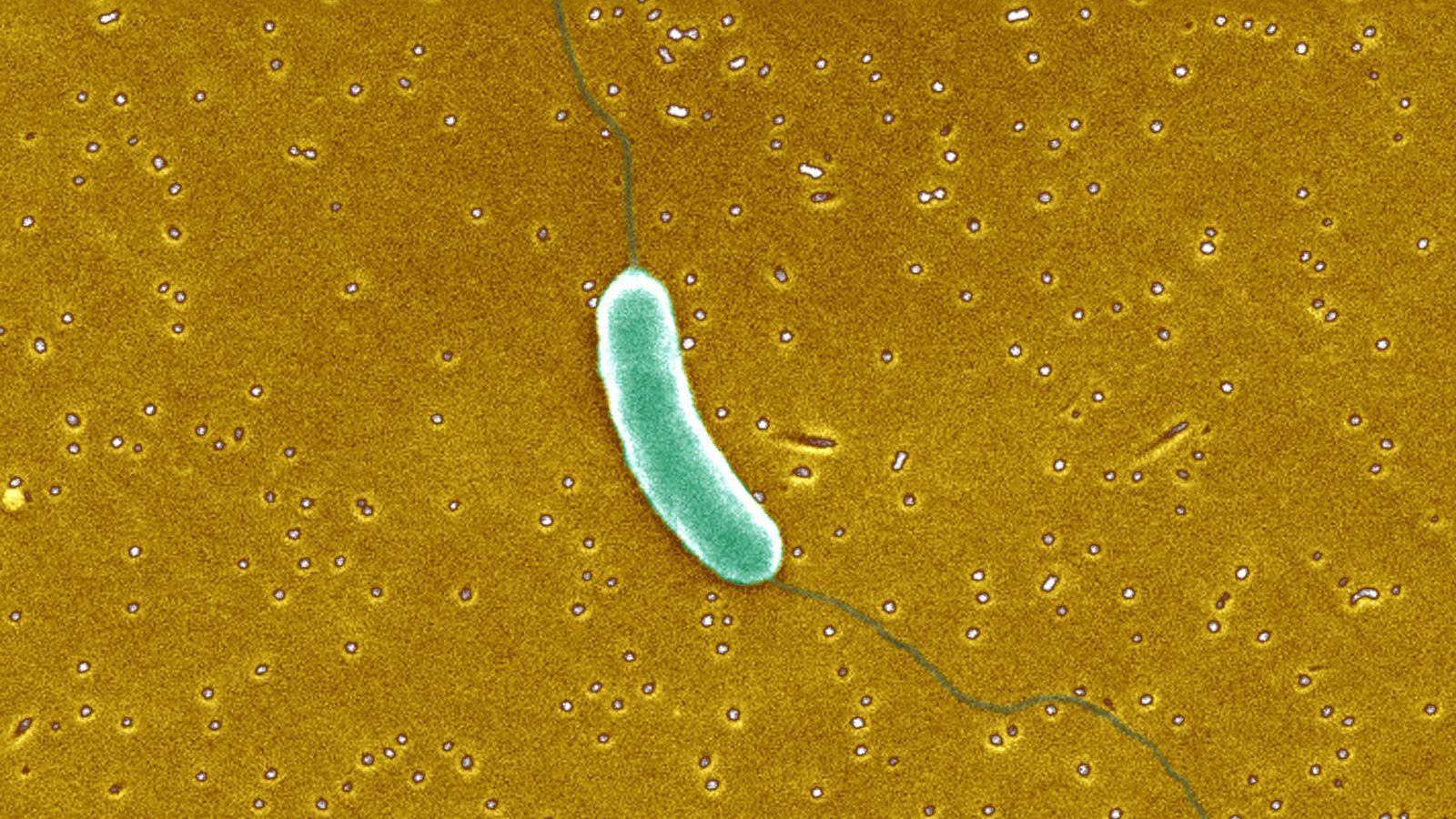
Hurricane Ian slammed into southwest Florida as a Category 4 storm in September last year, killing 149 people — the most deaths attributable to a single hurricane in the state in nearly a century. But the official death count didn’t include one of the most gruesome ways people died as a result of the storm.
A study published this week found that Hurricane Ian led to a spike in cases of vibriosis, a life-threatening illness caused by a water-borne bacteria called Vibrio, in Florida. In Lee County, where Ian made landfall, 38 people were sickened by the bacteria and 11 people ultimately died in the month following the storm — the highest number of Vibrio cases in a single month in Florida in more than 30 years. There had been no reported cases of Vibrio in the state in the week leading up to the hurricane.
There are many species of Vibrio, including Vibrio cholerae — the cause of the diarrheal disease cholera, which kills tens of thousands of people per year in the Global South. Vibrio vulnificus, commonly referred to as “flesh-eating bacteria,” is less common globally but more deadly, and it’s becoming more pervasive in the U.S. Vibrio vulnificus kills an estimated 1 in 5 people who are exposed to it, usually either by eating uncooked shellfish or by making contact with the bacteria via an open wound. Three people died after consuming shellfish tainted by Vibrio vulnificus or otherwise being exposed to the bacteria in New York and Connecticut earlier this year.

Past research has shown that warming ocean surface temperatures are leading to more Vibrio bacteria in the world’s oceans, particularly in the Atlantic, which is heating up at an alarming and unprecedented rate. A study published in Nature this year — the most comprehensive scientific assessment of how climate change is influencing the distribution of the bacteria to date — predicted that Vibrio vulnificus is likely to be present in every eastern U.S. state by the end of this century.
The study published this week, led by Rita Colwell, a microbiologist at the University of Maryland and one of the foremost Vibrio researchers in the nation, is among the first to make a direct link between a specific hurricane and a spike in cases of vibriosis. Colwell and her colleagues found that flooding brought on by Hurricane Ian caused millions of gallons of water to run into the ocean, carrying nutrients with it. The storm also stirred up sediment and warm water off the coast of Florida. The runoff, sediment, and high sea-surface temperatures triggered an explosion of Vibrio vulnificus and other types of Vibrio bacteria in the waters off the Florida coast, growth the researchers were able to document using satellite observations and shellfish samples from October 2022.
Gabriel Filippelli, a climate change researcher and director of Indiana University’s Environmental Resilience Institute, said he would have expected Hurricane Ian’s impacts to produce a “blip” in Vibrio abundance off Florida’s coast “and then a recovery back to baseline.” But that’s not what the study says happened. “It actually ramped up not only the abundance of Vibrio but some of the particular species that are problematic,” Filippelli, who was not involved in the research, said.
Colwell wasn’t surprised by her findings — the ocean water around Florida was abnormally warm last year and has continued to warm since. Her own prior research has shown that temperature anomalies lead to the growth of these harmful bacteria. Warm water also breeds stronger hurricanes, and adding a storm to conditions that already favored Vibrio had a predictable outcome. “We took samples and, sure enough, we found lots of Vibrio,” Colwell said.
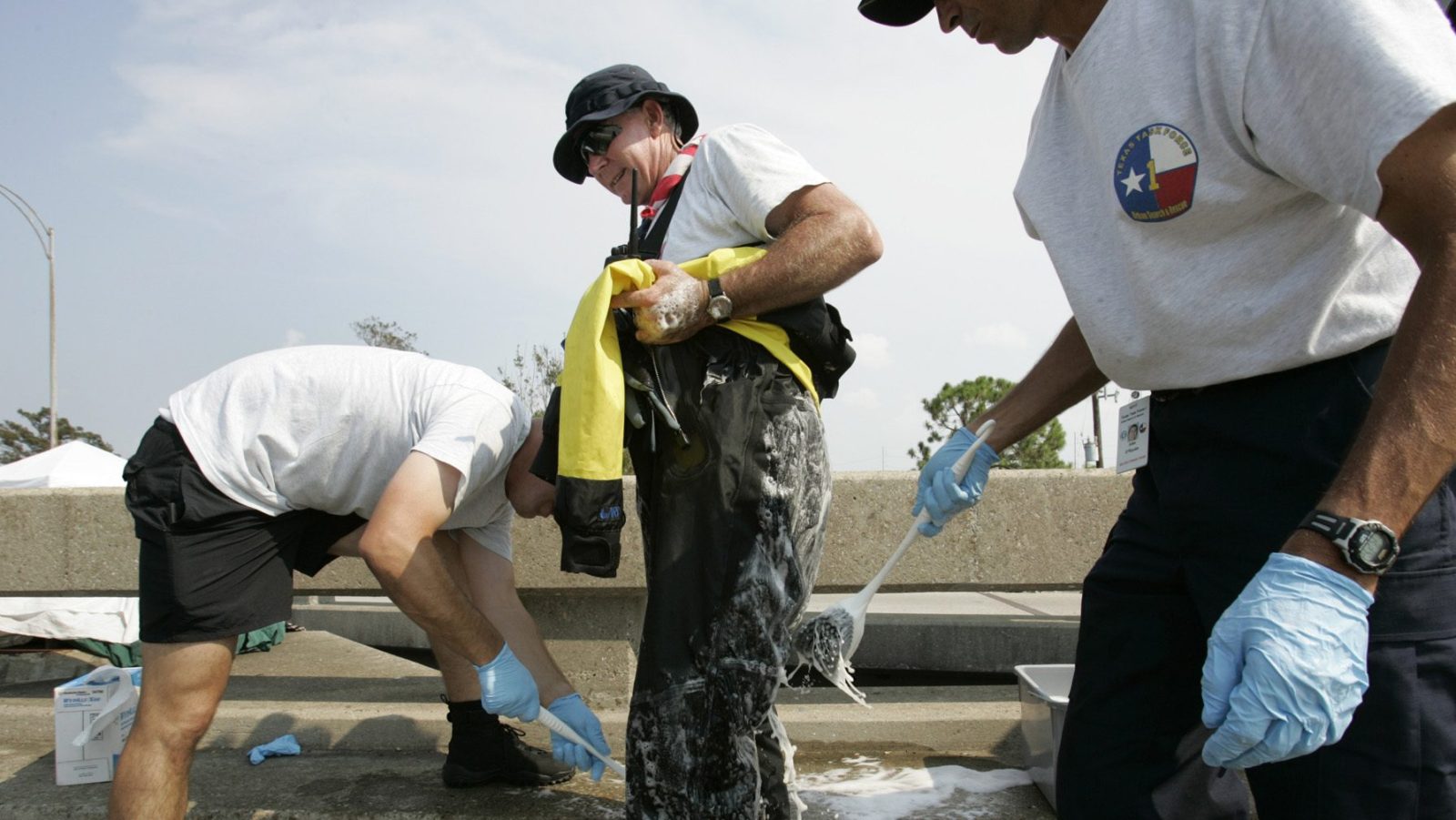
The results, she said, signal that public health officials everywhere, but particularly in hurricane-prone states, need to be aware of the potential threat that Vibrio bacteria pose to their communities. Climate change continues to create conditions that are conducive to larger and more intense storms, which could mean more vibriosis in humans as time goes on.
Filippelli hopes this study and other research to come will help local governments limit injuries and death during and after big storms. With the right data, local public health departments would be able to warn communities about the potential for toxins in shellfish and waterways following a hurricane or extreme flooding event. “That’s kind of the point of doing a lot of this,” Filippelli said. “It’s not just watching the climatic horror show emerge but trying to get ahead of it.”
This story was originally published by Grist with the headline Hurricane Ian stirred up flesh-eating bacteria in Florida on Oct 20, 2023.
Spending time in nature, whether it be deep in the wilderness, on a walk through a park or surrounded by the trees and plants in your own backyard, has been shown to have positive impacts on well-being.
A new study by an international team of researchers has found that green space — the vegetation in parks, public spaces and gardens — has a positive effect on an important genetic marker related to exposure to stress, a press release from North Carolina State University (NC State) said.
The study also found that green space’s positive impact is not enough to make up for other environmental challenges like systemic racism.
“The exposome, reflecting the range of environmental exposures individuals encounter throughout their life, can influence a variety of health outcomes and can play a role in how the environment impacts our genes,” the authors of the study wrote. “Telomeres, genetic structures regulating cell growth and senescence, are one pathway through which the exposome may impact health. Greenspace exposure, representing the amount of green areas in one’s neighborhood, is one component of the exposome and has been associated with multiple health benefits.”
Telomeres, sections of DNA at both ends of a chromosome, protect the chromosomes’ ends from damage, according to the press release. But with each division of a cell, the telomeres become slightly shorter. When the telomeres are so short the cell can no longer successfully divide, it results in cell death.
“This makes telomeres important markers of biological age, or how worn down our cells are,” said lead author of the study Scott Ogletree, who is a former postdoctoral researcher at NC State’s Center for Geospatial Analytics, in the press release. “And we know that many variables — such as stress — can influence how quickly our telomeres wear down.” Ogletree is now a professor of landscape and wellbeing at the University of Edinburgh.
The study, “The relationship between greenspace exposure and telomere length in the National Health and Nutrition Examination Survey,” was published in the journal Science of the Total Environment.
“There’s a lot of research that talks about the various ways in which greenspace is beneficial, and a lot of research that talks about adverse health effects associated with pollution, racist segregation in housing, and other social and environmental challenges,” said Aaron Hipp, co-author of the study and a professor of parks, recreation and tourism management at NC State. “This study was an attempt to quantify the beneficial impacts of greenspace at the cellular level, and the extent to which greenspace can help to offset environmental harms.”
For the study, the researchers used data from the Centers for Disease Control and Prevention’s National Health and Nutrition Examination Survey (NHANES) from 1999 to 2002. NHANES is a study that uses physical examinations and interviews to assess the health of the country’s population.
The research team examined the length of the telomeres, as well as location and demographic data, for 7,827 people. The team looked at how much green space each person’s neighborhood had and its relationship to the length of their telomeres.
The team took into account potential variables like health history, lifestyle and substance use. They also pinpointed other environmental variables that had the potential to affect telomere length, like air quality and “redlining” maps used to track historically segregated neighborhoods.
“We found that the more greenspace people had in their neighborhoods, the longer their telomeres were. That was true regardless of race, economic status, whether they were drinkers or smokers, etc.,” Hipp said in the press release.
Ogletree pointed out that some circumstances were found to negate the positive effect on telomeres.
“That’s the good news,” Ogletree said. “However, when we accounted for other characteristics of each neighborhood — air pollution, segregation, or ‘deprivation’ — the positive effect of the greenspace essentially disappeared. Deprivation, in this context, was an overarching variable that included the neighborhood-level data on income, education, employment status, and housing conditions. In other words, while greenspace seems to help protect telomere length, the harm from other factors appears to offset that protection.”
While green space is essential to well-being, so is the addressing of environmental factors that are damaging to individuals and society.
“Greenspace is tremendously valuable for a community, but it is not enough to overcome systemic racism and the effects of economic segregation and environmental justice challenges on its own,” Hipp said in the press release. “This study drives home the idea that creating greenspace in a community is important, but it’s as crucial — or more crucial — for us to address environmental harms, particularly those tied to systemic racism.”
The post Green Space Boosts Health at the Cellular Level, Study Finds appeared first on EcoWatch.